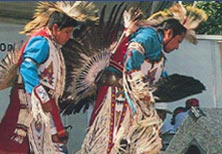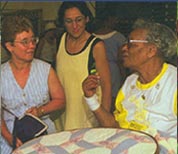






| Resources | ||||||
|
||||||
| Learning Guide |
| 1. Social Studies |
| 2. Language Arts |
| 3. Music |
| 4. Art |
| 5. Special: Multi-Disciplinary, Culminating Activities |
|
This lesson is about music within religious tradition and not about a specific faith. It focuses on how learning about the a cappella gospel singing of the Deer Creek Quartet and the African-American gospel music of the group Psalms can provide students with a means for understanding how traditional styles of music are part of the culture of religious communities.
Folklife Background Iowa is the home of various communities that have been shaped by their different religious traditions, and within these faith traditions are distinct styles of music. For example, within many early Mennonite churches in Iowa, the use of instruments was not allowed, so a characteristic style of singing developed that has remained popular today. This style is a cappella gospel quartet singing. “A cappella” comes from an Italian phrase which means “according to chapel” and means that singers perform without instrumental accompaniment. A cappella singing is characteristic of many religious traditions including the Gregorian chants of monasteries, the singing of Jewish cantors within synagogues, the calls to prayer of Muslims, and the meditative chanting of mantras that is a part of many forms of Buddhist practice. The Deer Creek Quartet from Wellman is made up of members from an “Old” Mennonite background, a progressive branch of the Mennonite church. The group blends the Mennonite tradition of sacred four-part harmony with influences from Southern gospel. By integrating a female vocalist, the Deer Creek Quartet breaks with the all-male tradition of many groups. In African-American history, the church has played a significant role and continues to be an important center for community within many Black neighborhoods. An important part of African-American religious expression is gospel music. Influenced in part by European hymnody, this genre was developed from the early spirituals, jubilee songs, and other sacred musical expressions. While many gospel songs are written down, the tradition of gospel singing also features a strong influence from oral sources and customary practice. Numerous gospel selections are learned by people’s participation in gospel sings. The group Psalms is from the Cedar Rapids area. The members, several of whom are related, began singing together over 20 years ago under the direction of “Aunt” Doris Akers, a local gospel performer who composed over 500 gospel songs. Children of Psalms, made up of ten children and grandchildren of Psalms members, preserves this family music-making tradition, and performs with their elders. |
Previous |
| | Next |
| Objectives | ||||||
Students will be able to:
|
| Cross References |
Instructional Program: The Mormon Trail |
| smithsonian institution |
 |
pioneer hi-bred international, inc. |
iowa sesquicentennial commission |
 |
iowa arts council |
